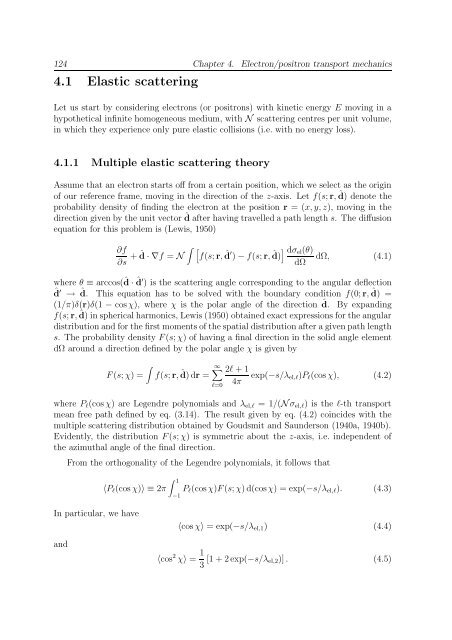PENELOPE 2003 - OECD Nuclear Energy Agency
PENELOPE 2003 - OECD Nuclear Energy Agency
PENELOPE 2003 - OECD Nuclear Energy Agency
Create successful ePaper yourself
Turn your PDF publications into a flip-book with our unique Google optimized e-Paper software.
124 Chapter 4. Electron/positron transport mechanics<br />
4.1 Elastic scattering<br />
Let us start by considering electrons (or positrons) with kinetic energy E moving in a<br />
hypothetical infinite homogeneous medium, with N scattering centres per unit volume,<br />
in which they experience only pure elastic collisions (i.e. with no energy loss).<br />
4.1.1 Multiple elastic scattering theory<br />
Assume that an electron starts off from a certain position, which we select as the origin<br />
of our reference frame, moving in the direction of the z-axis. Let f(s; r, ˆd) denote the<br />
probability density of finding the electron at the position r = (x, y, z), moving in the<br />
direction given by the unit vector ˆd after having travelled a path length s. The diffusion<br />
equation for this problem is (Lewis, 1950)<br />
∂f<br />
∂s + ˆd<br />
∫ [<br />
· ∇f = N f(s; r, ˆd′ ) − f(s; r, ˆd) ] dσ el (θ)<br />
dΩ, (4.1)<br />
dΩ<br />
where θ ≡ arccos(ˆd · ˆd ′ ) is the scattering angle corresponding to the angular deflection<br />
ˆd ′ → ˆd. This equation has to be solved with the boundary condition f(0; r, ˆd) =<br />
(1/π)δ(r)δ(1 − cos χ), where χ is the polar angle of the direction ˆd. By expanding<br />
f(s; r, ˆd) in spherical harmonics, Lewis (1950) obtained exact expressions for the angular<br />
distribution and for the first moments of the spatial distribution after a given path length<br />
s. The probability density F (s; χ) of having a final direction in the solid angle element<br />
dΩ around a direction defined by the polar angle χ is given by<br />
∫<br />
F (s; χ) =<br />
f(s; r, ˆd) dr =<br />
∞∑<br />
l=0<br />
2l + 1<br />
4π exp(−s/λ el,l)P l (cos χ), (4.2)<br />
where P l (cos χ) are Legendre polynomials and λ el,l = 1/(N σ el,l ) is the l-th transport<br />
mean free path defined by eq. (3.14). The result given by eq. (4.2) coincides with the<br />
multiple scattering distribution obtained by Goudsmit and Saunderson (1940a, 1940b).<br />
Evidently, the distribution F (s; χ) is symmetric about the z-axis, i.e. independent of<br />
the azimuthal angle of the final direction.<br />
From the orthogonality of the Legendre polynomials, it follows that<br />
∫ 1<br />
〈P l (cos χ)〉 ≡ 2π P l (cos χ)F (s; χ) d(cos χ) = exp(−s/λ el,l ). (4.3)<br />
−1<br />
In particular, we have<br />
and<br />
〈cos χ〉 = exp(−s/λ el,1 ) (4.4)<br />
〈cos 2 χ〉 = 1 3 [1 + 2 exp(−s/λ el,2)] . (4.5)
















